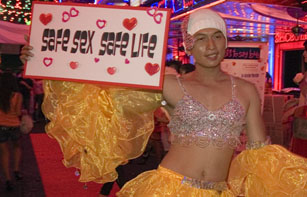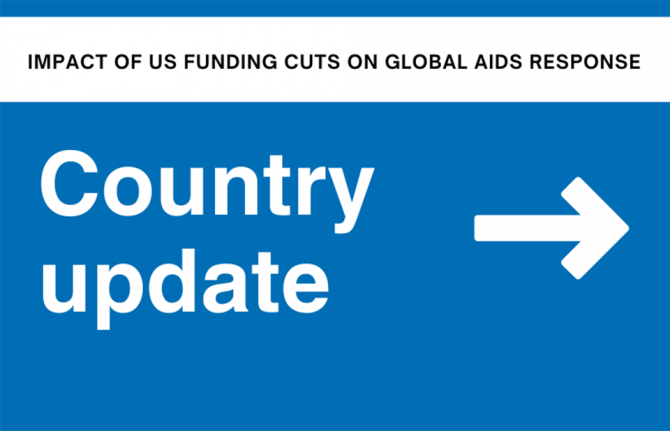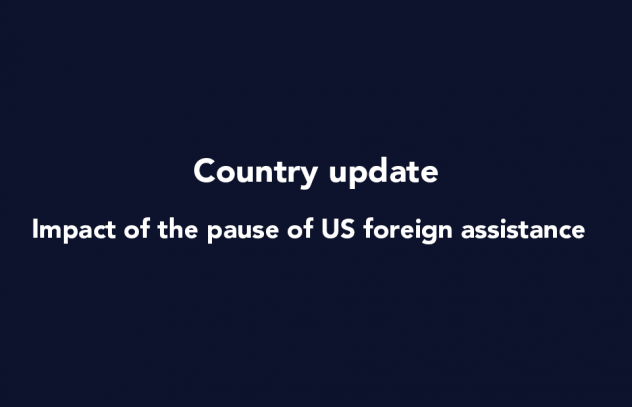
Feature Story
Getting into the SWING of it: Why key affected populations need to be front and centre of HIV responses in Asia and the Pacific
17 February 2011
17 February 2011 17 February 2011
This SWING Foundation volunteer was one of many to promote messages of HIV prevention and safe sex on Valentine’s night in Bangkok. Credit: UNAIDS
High heels, sequined outfits and pumping music fill Bangkok’s ‘Soi Cowboy’ street. For many, it’s a typical evening in one of the city’s well-known red-light zones. But a closer look at the fashion parade tells that this isn’t just any other night—the elaborately designed outfits, made entirely from condoms, are part of a Valentine’s night HIV prevention drive led by SWING (Service Workers In Group) Foundation, a Thai-based non-governmental organization.
With HIV prevention-slogan banners raised high in the air—“Safe sex, safe life!”, “Heart of love, heart of condom!”— volunteers from SWING walk the temporary runway, handing out condoms and information leaflets. Such targeted HIV prevention drives are just one aspect of SWING’s work with men, women and transgendered “service workers,” SWING’s preferred terminology for sex worker.
Based in the Thai red light districts of Bangkok, Pattaya and Ko Samui, the SWING Foundation provides educational opportunities for workers, including English language classes and vocational training. The Foundation also serves as a drop-in centre where workers can stop by, eat, use the internet, prepare for the evening, and take part in HIV-related information games and sessions.
“Our activities help workers increase their self confidence and possibilities to develop their individual potential,” said Surang Janyam, who co-founded SWING in 2004. “For many, it is so hard to feel they can get support, and they fear discrimination. SWING provides a safe space and options,” she added.
An established success story in Thailand, SWING’s reputation is spreading across borders as a model for programmes that provide HIV services where they are most needed. Its success is ascribed in part to the fact that Foundation is managed and run almost entirely by current or former sex workers.
Across the Asia-Pacific region, an increase in the size and scale of programmes focused on populations at higher risk of HIV exposure—planned and implemented by the communities themselves—is urgently needed.
In the Asia-Pacific region, we know that HIV responses must focus solidly on key affected populations if we are to sustain and advance progress
UNAIDS Executive Director Michel Sidibé
According to the latest available data, most epidemics in the region are still concentrated among people who inject drugs, sex workers and men who have sex with men. In a number of countries, there are signs of increased HIV infection rates among these key affected populations. Data, where available, on HIV prevention coverage from a number of countries across the region suggest that less than half—and in some cases only one third—of people from key affected populations have been reached by prevention services.
“In the Asia-Pacific region, we know that HIV responses must focus solidly on key affected populations if we are to sustain and advance progress,” said UNAIDS Executive Director Michel Sidibé, who was a special guest at the Valentine’s event hosted by SWING. “We need to drive commitment and action to ensure programmes like SWING are emulated and multiplied across the region,” he added.
In Soi Cowboy on Valentine’s night, the message is loud and clear: Nothing about us without us. “We care about you!” shouted SWING co-founder Khun Tee through a megaphone, as his colleagues paraded by in their colourful condom combinations. “HIV is real—please use a condom every time you have sex with anyone!”



